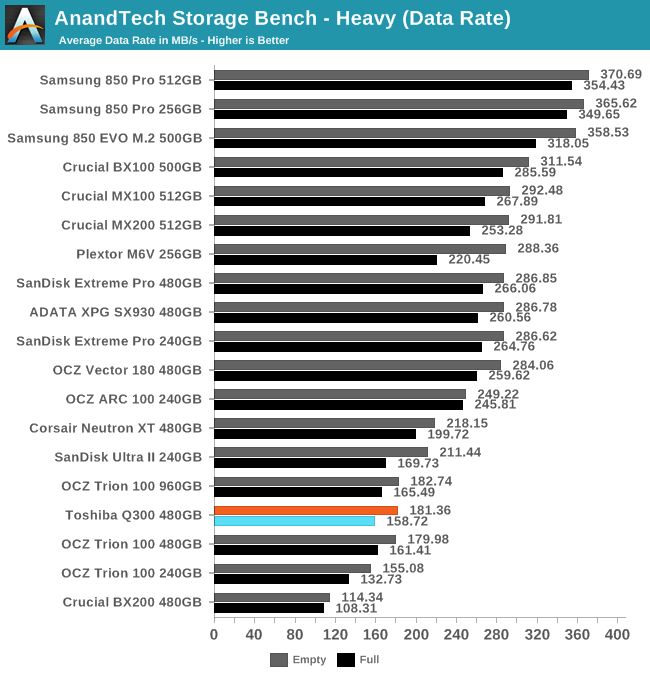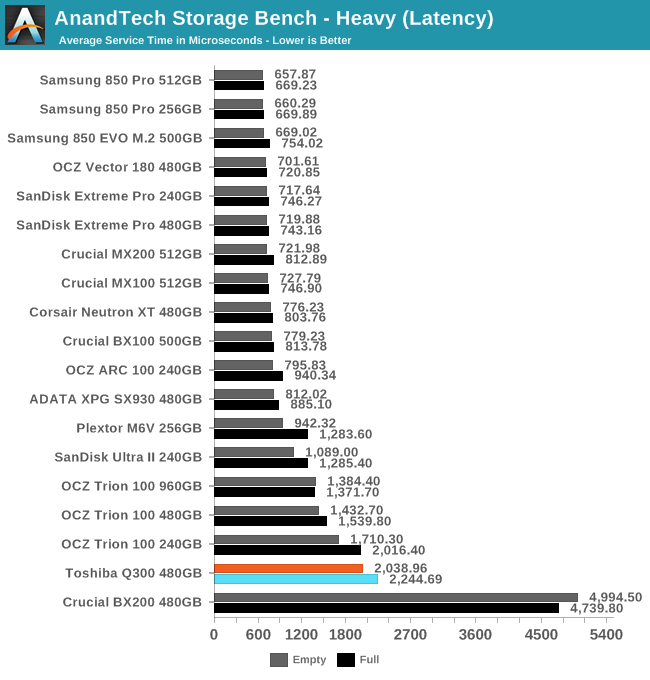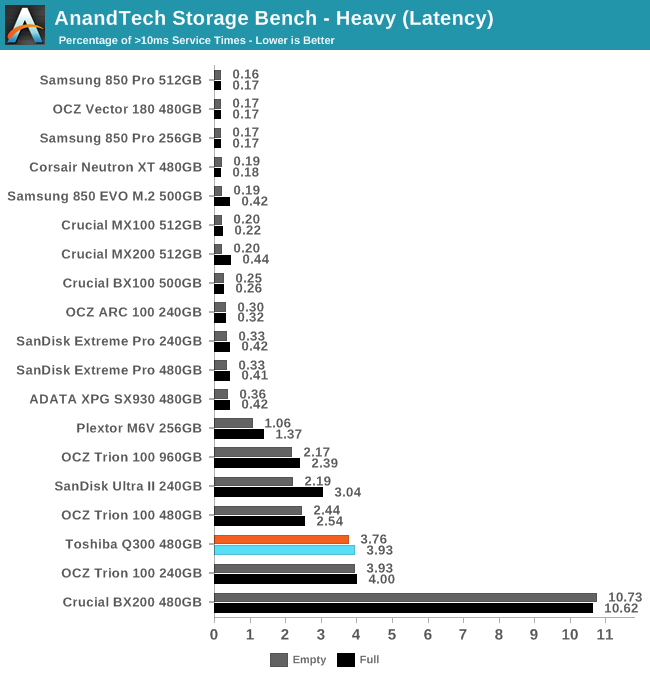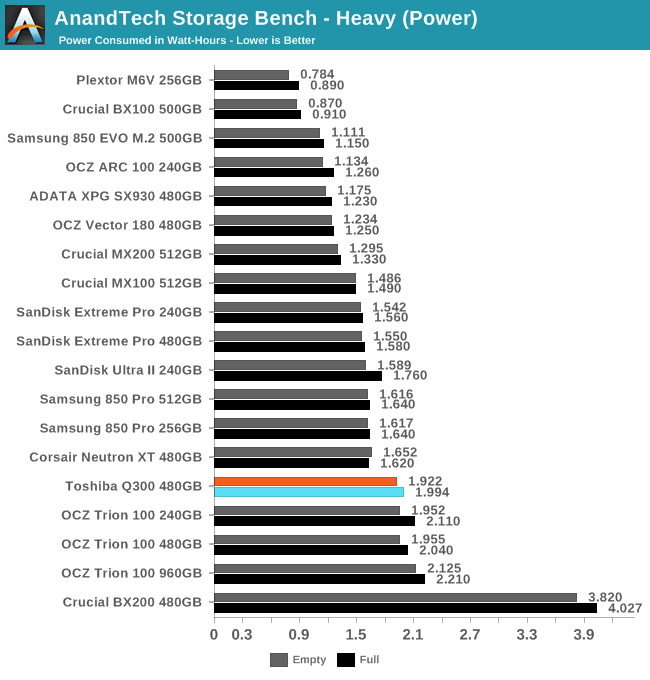The Toshiba Q300 SSD Review: Toshiba Becomes a Retail Brand
by Billy Tallis on February 26, 2016 8:00 AM ESTAnandTech Storage Bench - Heavy
Our Heavy storage benchmark is proportionally more write-heavy than The Destroyer, but much shorter overall. The total writes in the Heavy test aren't enough to fill the drive, so performance never drops down to steady state. This test is far more representative of a power user's day to day usage, and is heavily influenced by the drive's peak performance. The Heavy workload test details can be found here. This test is conducted twice, with the drive full and empty.

The Q300's average data rate on the ATSB Heavy test is the same as the Trion 100: low but not the worst we've seen, and about half what the Samsung 850 Pro delivers. All of the planar TLC drives perform worse than all of the MLC drives.

The Q300's average service time is again worse than the Trion 100, and is about twice that of the slowest MLC drive. The BX200 puts things in perspective: the Q300 is a disappointment, but isn't truly broken.

Most MLC drives are able to keep latency under 10ms almost all of the time, but the TLC drives get overwhelmed during the more intense parts of the test. The Q300 is worse than the Trion 100 480GB, but this time isn't worse than the smaller Trion 100.

The Q300 continues to be slightly more power efficient than the Trion 100, but the gap separating it from the MLC drives is quite clear. The SanDisk Ultra II managed to get much better efficiency out of nearly-identical TLC flash.










30 Comments
View All Comments
kmmatney - Friday, February 26, 2016 - link
I upgraded my laptop from a Samsung 830 to a SanDisk Ultra II 980GB (TLC + SLC cache) and the Ultra II is noticeably faster in everyday use. Anand reviewed it a while back and it was one of the lower powered drives as well - in fact more efficient than MX100 according to the review.Oyster - Friday, February 26, 2016 - link
I have a radical suggestion, guys. Can you please start review articles with the price comparison? This (price comparison) just seems out of place since the rest of the product attributes are already being compared to the competition on the first page. I often find myself jumping between the first and the last pages just to compare items. Plus there have been times when I have just skipped to the last page just for the price comparison... case in point, some of the ridiculously-priced mechanical keyboards - I know they're not even worth my time at $150.Also, when are you implementing single-page views??? :)
nathanddrews - Friday, February 26, 2016 - link
Hopefully never. If you want single-page, just click "Print This Article":http://www.anandtech.com/print/10084/the-toshiba-q...
aggressor - Friday, February 26, 2016 - link
Is this really considered their first retail drive? What about the Toshiba THNSNH model they released in 2013? I have one of them and it was retail boxed.jjj - Friday, February 26, 2016 - link
You should include PCIe drives in the results as prices are becoming more reasonable and the high end SATA models less appealing.ddriver - Friday, February 26, 2016 - link
Toshiba needs to reevaluate their pricing - 140$ for the 480GB model is far from a good deal considering that for 20$ extra you can get an evo which is significantly faster, has significantly longer warranty period and has 20GB extra capacity.mczak - Friday, February 26, 2016 - link
I wonder how the different Q300 differ and compare to each other?There's two series available: Q300 RG4 (models starting with HDTS7xxx) and Q300 RG5 (HDTS8xxx). The RG5 seems to be newer, I assume different flash (the tested one can be identified as a RG4 in the picture). But for all I know they could have completely different characteristics despite Toshiba wanting to believe you it's all the same...
mczak - Friday, February 26, 2016 - link
I suppose actually flash is going to be the difference - 15nm vs 19nm, so it would be like a Trion 150 (though the Trion 150 had 3 differences vs. the Trion 100, 15nm flash instead of 19nm, newer firmware (with larger SLC buffer), plus a thermal pad for the controller chip, the latter was likely the reason it had faster sustained write performance, and those other differences might not carry over to the Q300 - so there might not be much difference in the end after all).harrynsally - Friday, February 26, 2016 - link
?????? it appears that Toshiba's strategy may have been to use the Trion 100's earlier release to make sure everything was working properly before releasing the Q300 to catch the eye of a wider audience??????Just checked Newegg Trion 100 owner reviews.
44% rated the 120GB drive 1 star and 41% rated the 240GB drive 1 star.
Appears that OCZ SSDs still lack in quality, reliability and performance,
wagon153 - Friday, February 26, 2016 - link
You're taking Newegg reviews serious? Lol. The Kingston V300 has 4 stars and is as bad, if not worse then, old OCZ drives.